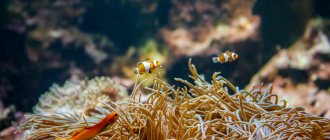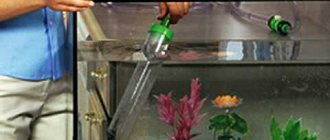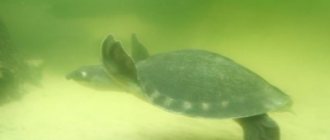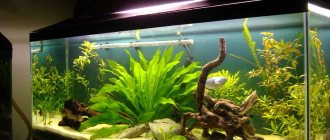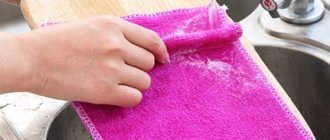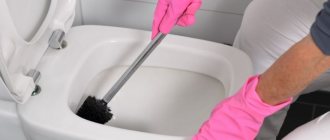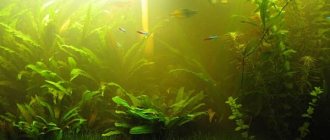How to siphon soil in an aquarium ? Hello! Dear readers of the aquarist’s blog Aqua-As. In this short review we will deal with the question of how to siphon soil in an aquarium and why do it at all? Perhaps these questions will only make experienced aquarists smile, but aquarium lovers who are just taking their first steps in this exciting activity quite often ask these questions.
At the bottom of our aquarium. Over time, the products of life activity accumulate in the aquarium. This is waste from fish and shellfish, uneaten food, rotting stems and leaves of plants. In a properly organized aquarium with a stable balance, this is a natural process. But over time, the amount of organic matter in the soil can reach a certain critical mass. Especially in aquariums with few plants or slow growing species and a large number of fish.
Why clean the bottom with a siphon?
In a thick layer of soil, especially if it is dense or compacted, oxygen-free zones gradually appear and putrefactive processes begin.
Plant roots rot, the water becomes cloudy and unsuitable for fish, and the accumulated hydrogen sulfide can simply poison them.
It is also necessary to regularly siphon aquariums without living plants and soil, since biological waste in them is not processed naturally, settles to the bottom and pollutes the aquarium.
Types of mud cleaners
Remove excess organic matter using an aquarium siphon.
Plastic flask
Plastic flask with a hose for soil siphoning
The simplest device is a plastic flask (glass) with a soft hose attached to it.
Many people make this design on their own, using part of a plastic bottle, tape and a polypropylene hose. Water is pumped according to the principle of overflowing vessels. But to do this, she needs to help and draw air from the tube until the liquid begins to move. If you are afraid of swallowing water, you can first fill the siphon with tap water, then lower the flask into the aquarium with the hole facing up while holding the other end of the hose with your fingers. When this end is released into the drain container, water will flow out of the aquarium. To prevent soil granules from flying into the hose during operation, it is squeezed by hand and then they fall back to their original place.
Plastic funnel attachment
Another type of mud cleaner is a wide plastic funnel attachment, a hose and a hand pump (bulb) for pumping up water.
Advantages and disadvantages of this method
Advantages of siphon cleaning:
- prevention of the formation of anaerobic zones, soil acidification, and the proliferation of harmful bacteria;
- parallel replacement of part of the water with fresh water;
- removal of organic waste that pollutes the aquarium.
Disadvantages of siphon cleaning:
- beneficial bacteria living in the top layer of soil die;
- biofiltration ability deteriorates;
- in the process, nutrients necessary for plant life are washed out of the soil;
- the root system of plants, especially small ones, is damaged.
Glass cleaning
Even if your aquarium is sparkling clean and tidy, green deposits will still appear on the walls. Over time, it will begin to increase and ruin the entire aesthetics of the reservoir. To get rid of them, you need to take a scraper (with a blade or a magnetic scraper) or a washcloth. If the depth of your aquarium is acceptable for working with a regular scraper, then go ahead. But there are times when getting to the aquarium from above is a big problem or its depth is very large. In this case, it is best to use a magnetic scraper. It does not scratch glass, only if some grain of sand gets between its working surface. The main disadvantage of such scrapers is that it is difficult to process the lower edge near the ground and corners.
You can also carry out this procedure with a household washcloth, but if your aquarium is made of plexiglass, it is better to put the washcloth aside. There is no need to catch all the algae that you remove from the walls from the aquarium; fish will eat it or it will partially merge with the water.
How often to wash?
The biological balance in each aquarium consists of many factors, such as the volume of water, the number and size of the inhabitants, the presence of living plants in it, the size and thickness of the soil. Taking into account all these features, you need to set an individual aquarium cleaning schedule.
If the volume of the aquarium is large, the fish are large, there are no plants or they are artificial, cleaning with a siphon should be carried out at least once every two weeks. In a densely populated aquarium, it is advisable to siphon the bottom once a week.
Fishing tanks with fry are usually without soil, therefore, to prevent severe contamination, they are siphoned once every two to three days.
How do you know when cleaning is needed?
An experienced aquarist will use a number of signs to determine the need for cleaning, but novice hobbyists will have to remember them and carefully monitor the condition of their aquarium.
First of all, you need to pay attention to the soil. If small bubbles are visible in the soil that float to the surface when stirred, this is a signal to immediately begin cleaning.
The process cannot be started; hydrogen sulfide in large quantities is dangerous for fish and, rising up during a siphon, can kill the inhabitants almost instantly.
If the aquarium is planted with live plants, you should regularly inspect their roots. The roots have changed color to brown, pockets of decay are visible - it’s time to siphon the soil.
There is also a test for contamination of an aquarium with organic matter: you need to use a syringe to take an extract from the soil and add a drop of a saturated solution of potassium permanganate to it. Then put it in a dark place for 40-50 minutes and then evaluate the result: yellow or brown color of the water will be a reason for immediate cleaning. Orange or pink color is a sign that the aquarium is clean enough and you don’t need to clean it for some time.
Solution proportions: 25 ml. water per teaspoon of potassium permanganate. All crystals should dissolve.
When is a siphon contraindicated?
The main principle: the more living plants there are in the aquarium, the less it needs cleaning with a siphon . Plants are excellent at processing organic waste, especially those species that have a branched root system and a root type of nutrition.
Herbal aquariums do not siphon at all; the plants cope with water purification on their own. A siphon is too rough a cleaning method for such aquariums; a funnel can damage the nutrient substrate needed by many types of plants. The inhabitants of such aquariums are, as a rule, small fish or shrimp, which do not pollute the water much.
If the aquarium contains soil, dried sludge or other nutritious soil, siphoning is contraindicated and impossible!
There is no need to siphon newly started aquariums either. In the first weeks after pouring, a colony of beneficial nitrifying bacteria should form in the top layer of soil; cleaning will only damage it.
When not to siphon
There is no need to clean the aquarium with a siphon when it is completely planted, there are a lot of shrimp, small snails and fry. Plant roots penetrate the soil and act as a natural aerator, releasing oxygen. Therefore, souring does not occur. The situation is different when the plants have unbranched, weak roots, and the soil lies in a thick layer.
You should definitely not siphon the soil in the following cases:
- the aquarium was launched less than two weeks ago;
- the colony of nitrifying microorganisms has not yet grown;
- Only aquatic plants are grown in the tank, and the siphon actively washes out the nutrient substrate.
There is a sure way to check the condition of the soil with plants: move it with a stick. If bubbles appear and cloudiness rises, it’s time to siphon. This means that the decay products of aquatic life rise up and become a source of pathogenic bacteria.
How to properly clean sand?
The principle of operation of the siphon is completely simple: water is drained from the aquarium due to gravity, by gravity . Even a completely novice aquarist can handle the process, but to be completely sure, you can ask someone to assist. A bucket is best for draining dirty water.
The bucket must be below the aquarium, otherwise the water will not flow!
The siphon funnel needs to be placed in the ground about two-thirds of its thickness , and a draft must be created - siphons can be equipped with a special bulb or even an electric motor, but you can simply suck up the water with your mouth.
The flow of suction water picks up everything that ends up in the cylinder or funnel, but heavy particles settle back, and light biological waste leaves through the hose. After this, the siphon funnel is moved and cleaning of another area begins. Thus, after the siphon, clean soil remains, without silt.
Cleaning is carried out carefully in biological systems with a low “population” density and partially planted with vegetation with a root feeding system. Siphon only open areas (with special care near the front glass), under snags and between decorations . In the area where plants are planted, the siphon is not deepened so as not to harm the roots.
If the soil in the aquarium is sandy, you should walk with a funnel near the surface of the soil without touching it. When cleaning an aquarium, do not drain more than 30% of the water!
How to use a homemade device?
If the farm does not have an industrial apparatus, and cleaning needs to be done urgently, you can quickly make a siphon yourself . To do this, you will need a flexible hose with a diameter of 1 mm, a 1-1.5 liter water bottle, electrical tape and odorless silicone sealant. The bottom of the bottle needs to be cut off; it will act as a funnel for suction. Next, connect all parts of the future siphon and treat the connections with sealant.
With such a device you can clean an aquarium in the same way as with an industrial one.
Alternative methods for cleaning soil
If necessary, you can clean the soil without a siphon. They do this as follows:
- The fish are transplanted into a separate container.
- The substrate is taken out of the aquarium into a bucket.
- Pour water into the bucket under pressure, stirring the soil periodically.
- Drain the cloudy water several times until it becomes clear.
- If the substrate is large, you can use a colander instead of a bucket. Soil washing will be faster and more efficient.
Do not use chemical cleaning agents. It is impossible to wash them without leaving a trace. If necessary, pebbles can be disinfected by boiling for 20 minutes. This way you can clean the bottom of the aquarium without draining the water.
How to clean less often?
The first and most effective way: reduce the number of fish in the aquarium and increase the number of living plants, preferably with an extensive root system . Feed the fish in moderation, avoid overfeeding.
Biological waste will be reduced and the remainder will be recycled by plants. Using filters for water purification will also make life much easier.
If the population of the aquarium is small, living plants cover most of it, the filter copes with water purification, and the soil is in good condition, there is no need for general cleaning.
You can get bottom aquarium snails - melania. These hardworking creatures eat waste, algae and perfectly mix the soil, preventing acidification. Melanias reproduce very actively!
What happens under ideal conditions?
A natural ecosystem involves a large number of participants. The remaining fish food is eaten by shrimp and snails. Rotten plants and small uneaten food residues are processed by protozoa bacteria. Next, plants with strong root systems consume the organic matter they need to grow.
It is not always possible to create such conditions in home aquariums. Imagine a container with cichlids. There will be no plants or shrimp there. Accordingly, there will be no one to eat the leftover food; the leftover food and fish waste products will accumulate in the ground. This is where you will need a siphon.
Video on the topic
Check out the tips and watch the process of cleaning an aquarium using a siphon in the video below:
The siphon can be called an indispensable assistant for the aquarist. At the same time, when cleaning the soil, you should remember that this is an intervention in the established ecosystem of the aquarium and should not be carried out too often or unless particularly necessary.
- Related Posts
- How to choose and prepare soil for an aquarium with live plants (herbalism) correctly?
- There must be enough soil! How much soil do you need in an aquarium?
- All about black aquarium soil
What types of siphons are there and how they work
Today, manufacturers present several types of siphons - mechanical and electrical. The models differ in a number of characteristics.
Before buying a specific device, you need to determine for which aquarium it will be used. The size of the siphon depends on this parameter:
- standard model – suitable for cleaning simple and large aquariums;
- smaller model – recommended for nano aquariums.
Electric devices operate on batteries and are designed for cleaning aquariums in which the water level is no more than 0.5 m. They can be used to siphon soil from a reservoir in several ways:
- the dirty liquid is sucked into the hose, after which it is sent to a separate container or directly to the sewer;
- Water is passed through a filter, then returned to the aquarium again, but in a purified form, so it does not require replacing it in large volumes.
The pressure force depends on the cross-section of the tube. The thicker it is, the stronger the pressure. There are also differences in the configuration of the cleaning funnel itself:
- rounded shape, there is one right angle - intended for standard cleaning;
- narrowed end of the tube - for cleaning hard-to-reach places.
If you attach a strainer to a funnel with a tube, only the smallest particles will be removed, while large waste remains at the bottom.
It is advisable to choose a siphon model equipped with a transparent tube, which will allow you to easily control the cleaning process.
Vegetation treatment
If there is living vegetation in an artificial reservoir, then it also requires care and purification. Plants can be cleaned at home, following certain rules:
- Plants do not like transplants.
- Vegetation is not processed during every harvesting operation.
- Spoiled and damaged leaves are cut off.
- Overgrown plants must be removed so that they do not become an obstacle to the free movement of fish.
- Pruning should be done as the bushes grow.
- Overgrown bushes should be thinned out so that they do not interfere with the penetration of light into the container.
- If it is necessary to remove a plant by its roots, the manipulation is carried out as carefully as possible to prevent the rise of turbidity from the substrate.
Aquarium disinfection
Disinfection is carried out in case of infection in the aquarium, when simple washing is not enough. The aquarium is filled to the brim with a disinfectant solution for 2 days, thoroughly washed and left to dry for at least a day. The fish should be placed in separate containers with clean water.
It is recommended to use disinfectants such as potassium permanganate, chloramine solution, formaldehyde, diluted hydrochloric and sulfuric acid.
It is recommended to heat treat (boil) the equipment used. All surfaces are treated with a disinfectant solution, including the filter, decorations, lid, etc.
Battery Powered Aquarium Gravel
264 Reviews 563 orders(s)
Specifications: Condition: 100% Brand New Material: Plastic Color: As shown in the picture Power Source: 2 x 1.5 VC batteries (not included) Drain Pipe Length: Approx. 67cm/26.38in Intake Pipe Length (3pcs): Approx. 18cm/7.09in, 20cm/7.87in, 40cm/15.75in Total length: min. 58cm/22.83in, 72cm/28.35in. 95cm/37.40in (adjustable) Normal water level: 30cm. Water level: 72 cm. : 520L/h Weight: approx. 373 g
Package Included: 1 x Gravel Cleaner Main Body(Battery Not Included) 3 x Water Inlet Pipes 1 x Drain Pipe 1 x Strainer Bag 1 x Blackhead and Pimple Remover Tool 1 x Cleaning Brush;
Note: 1. Please allow 0-2cm differs due to manual measurement. Thanks for understanding. 2. Monitors are not calibrated the same, item color displayed in photos may be slightly different from the actual item. Price: RUB 650.05
BUY ON ALIEXPRESS
Important Details
Allows you to regulate the intensity of the water flow passing through the device. It is not very convenient to carry out a siphon without such a tap; you always have to pinch the drain with your finger or change its height.
Mesh in the fence.
Finding and installing such a mesh on a homemade device is not so easy, so many aquarists prefer a purchased option. The mesh in the intake part of the hose prevents pebbles in the ground from being drawn into the apparatus and protects small-caliber inhabitants of the tank from the same fate. They would hardly like a high-speed descent through the device’s hose followed by a swim in dirty water.
Siphon drain filter.
The water pumped out during soil cleaning can be reused, only, of course, it must first be separated from the removed dirt. If you use the simplest siphon design, there is only one way to do this: wait until the dirt settles at the bottom of the drain container. But if you bought a device whose drain is equipped with a filter (usually a small cloth bag), then you will immediately receive clean water suitable for reuse. The main thing to remember is: if the fish’s habitat has not been cleaned for a very long time, the pumped out water cannot be reused, even if a filter is installed on the drain of the device. Nitrites and ammonium salts contained in large quantities in the drained water will poison the tank environment and cause the death of all living organisms in it.
Loading …
You might be interested
7 Best Aquarium Soils
How to choose an aquarium filter
How to choose a compressor for an aquarium
Choosing a background for the aquarium
How to clean an aquarium
Special means
These are specially developed cleaning products, after use of which you need to completely wash off the remaining particles so as not to harm the inhabitants.
Examples of cleaning products:
- wipes with impregnation to dissolve lime and green deposits;
- spray for cleaning glass from calcification;
- filter softener that reduces the level of hardness, etc.
To use the above products, it is recommended to completely empty the aquarium and, in the case of the latter, to use it for a short period of time.
Folk remedies
In the event that there are no special cleaning products at hand, an alternative replacement with products available on the farm is possible:
- Baking soda is the most famous cleaning agent.
- Vinegar (9%) copes with white plaque. A tablespoon of vinegar per 200 grams of water.
- Wine vinegar will replace glass cleaner. A spoonful of vinegar dissolves in a glass of water, leaves no streaks and quickly removes plaque.
- Citric acid is effective against calcium deposits. 20 grams of powder are diluted in a glass of water.
- Ammonia is also used for decalcification. Diluted in a ratio of 1:10.
- Hydrogen peroxide is another effective option. The substance is diluted in a ratio of 1:15. Peroxide will help in case of rapid spread of algae, filter malfunction, etc. It allows you to saturate the water with oxygen and oxidize the resulting organic matter. The solution is sprayed in a thin stream into the filter, which will gradually release it into the water. After about an hour, the water is changed to remove dead organic matter.
To use liquid solutions, it is most convenient to use spray bottles.
What products are not recommended for cleaning an aquarium?
It is not recommended to use regular glass cleaners as they contain ammonia, which is toxic to fish, as well as regular cleaning agents. As in the case of special and folk remedies, this is caused by the likelihood that residues of the product will remain on the surface. Only in the case of chemicals does this chance increase many times over, since the stronger the chemical, the more difficult it is to wash it off.
Points to pay attention to when purchasing a siphon
Having decided to purchase this device and coming to the store, you can find a large amount of this product on the shelves. In order not to make a mistake with your choice and buy exactly what you need, you should follow these tips:
- The hose of the device should have a diameter that exceeds the diameter of the aquarium pebbles by 2 - 3 millimeters. Hoses with a diameter of 8 to 12 millimeters are often used.
- The recommended material from which the hose should be made is polyvinyl chloride. It is soft, elastic and compact.
- To secure the hose, it is better to purchase additional clamps or brackets. This way it will not fall off the drain spout.
- The height of the glass must be at least 25 centimeters. Such a device will not suck in even the smallest pebbles.
Cleaner fish, snails and other helpers that clean the aquarium
There are biological organisms that prefer to feed on algae, organic debris, and rotten plant leaves. They help clean the aquarium from the inside.
- Cleaner fish (Siamese algae eaters, otocinclus, ancistrus, etc.).
- Algae-eating snails (Helena, Javanese corbicula, porcelain septaria, etc.).
- Algae-eating shrimp (amano, cherry shrimp, neocardines, etc.).
- Catfish (dwarf and brocade catfish, ancistrus), etc.
